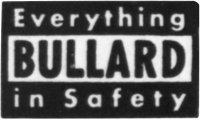E.D. Bullard Co.
The E.D. Bullard Company, or Bullard, is a manufacturer of personal protective equipment and industrial safety equipment, formerly located in San Francisco, California. During World War II, they produced a variety of sirens, which were used for air raids, emergency vehicles, industrial warning, and even as fog horns. The company no longer produces sirens today, having ended siren production by the mid-late 1940s. The company is known for having invented the hard hat in 1919. Bullard continues to produce personal protective equipment in Cynthiana, Kentucky to this day, and they even have a restored Bullard siren which is sounded to kick off production of a new product.
History
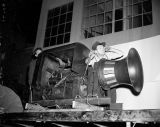
E.D. Bullard Co. was formed in 1898, and was named after its founder, Edward Dickinson Bullard. The company originated with manufacturing gold and silver mine safety equipment and is credited with the invention of the hard hat in 1919. As early as 1934, Bullard purchased siren designs from the Siracode Signal Co., which was going under, and started producing their designs under the name "SIGNAL-MASTER."
Bullard's sirens had a distinctive tapered rotor and stator, and horizontal models had a special parabolic projector to force sound in one direction. Most Bullard sirens also came equipped with intake horns. Bullard claimed that the purpose of the tapered rotors and stators was to force sound in one direction, however, it is believed that the real reason was to help get better tolerances between the rotor and stator without a complicated machining process, as all it took was a small adjustment to bring the rotor closer to the stator.
The company created a variety of different sirens, ranging from large coding sirens to be used as fog horns, to small vehicular sirens for police cars and fire apparatus. Bullard even created a large gasoline powered siren, some of which were known to have their rotors explode during regular operation, and also generally performing inadequately. Bullard also submitted their gas siren design to Chrysler, but because the siren did not perform well enough, an official partnership was never formed. This lead to Chrysler's partnership with Bell Laboratories to create the Chrysler Air Raid Siren.
E.D. Bullard's coding sirens worked exactly like the units created by Siracode. They utilized a sleeve around the stator that has the same amount of intake and exhaust ports, which a solenoid turned, closing the siren completely to instantly silence it, similar to a Fedelcode Model 2. With this mechanism, the siren could blow specially timed pulses, which was a useful tool for fire departments and for bridges which would use sirens as electric fog horns. This coding mechanism was referred to by Bullard as the "Siracode Mechanism" for a short time, but the name was seemingly dropped after a short period.
After the war ended, sales of Bullard's sirens slowed as companies such as Federal Electric were proving dominant in the siren market across the United States. The company was never able to outcompete the many other siren manufacturers at the time, both locally and abroad, leading to the company ending production of their sirens sometime after 1946, but their sirens continued to be used during the Cold War, supplemented with other sirens of various makes and models. This would not be the end of the company, as Bullard would continue to enjoy relative success in the industrial safety equipment market, where it stands today.
Products
SIGNAL-MASTER Sirens
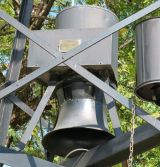
Model V
The Model V is E.D. Bullard's standard vertical siren, ranging anywhere from 1 to 15 horsepower. They came with 12, 16½, and 20 inch rotors, which intake air from the bottom and are driven by an electric motor on top. Confirmed port counts are 7 port for the 12" rotor, 6 and 12 ports for the 16½" rotor, and 12 port for the 20" rotor. Most Model Vs have intake horns on the bottom of the stator, as well as three or four stand legs attached to the top of the stator, which extend down inches or feet past the bottom of the siren, depending on where the legs were cut.
On the tag, "V" is prefixed by the siren's horsepower, and followed by the siren's coding capability. For instance, a 5 horsepower, coding capable siren will be tagged as "Model 5VC." If it's not coded, it may be tagged as "Model 5V" or "Model 5VNC," which means, "non-coded." Coded and non-coded variants of the Model V can be told apart very easily, as coded models typically have large box shaped housings above the stator, which encloses one or two solenoids, depending on the size of the siren, and a cylindrical partial motor hood above. A non-coded Model V will only have a tall cylindrical motor hood, attached directly to the stator.
While most Model Vs have 3 phase motors which spin at around 3,500 rpm, there has been one 7 port, single phase, 3 horsepower coded siren (3VC) documented with 5,000 rpm stamped on the tag, located in Volcano, California. It is unknown how many high speed Model Vs were produced, as Volcano's 3VC is the only one confirmed. About 11 Model Vs of various sizes still exist today, very few of which are active.
Model H
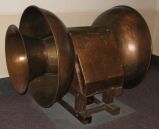
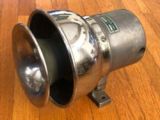
The Model H is E.D. Bullard's standard horizontal siren, ranging anywhere from ¼ to 15 horsepower. They are known to have came with 12, 16½, and 20 inch rotors, and could be single-headed or dual-headed, with an electric motor in the center on a stand tall enough to allow for horns, even if the siren has none. The size of the rotor on the smallest models are unknown. Confirmed port counts are 7 port for the 12" rotor, 6 and 12 ports for the 16½" rotor, and 12 port for the 20" rotor. Some Model Hs have intake horns on the front of the stator, as well as large parabolic projectors to force sound in one or two directions, depending on the siren's configuration. The Model H had multiple horn sizes, and could be easily swapped to meet the needs of the customer. The small fractional-horsepower sirens were meant for use in industrial settings instead of general-purpose use outdoor use.
On the tag, "H" is prefixed by the siren's horsepower, and followed by the siren's coding capability. For instance, a 5 horsepower, coding capable siren will be tagged as "Model 5HC." If it's not coded, it may be tagged as "Model 5H" or "Model 5HNC," which means, "non-coded." Coded and non-coded variants of the Model H can usually be told apart, as most coded models will have both horns standard, and will either have a wide, rounded motor hood which houses solenoids in the bottom, or a large box shaped motor hood to accommodate for solenoids above the motor. Many non-coded Model Hs have no housing at all, but they can have rounded motor hoods with straight size, similar to an ACA Allertor 125.
The Model H is an extremely uncommon siren, likely due to its cost compared to the Model V, which performed adequately for most customers. Roughly four Model Hs are known to exist, two of which are dual-headed. None of them are active.
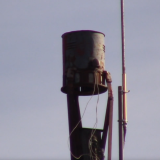
Model 3H
WIP
Industrial Sirens

Type S (Type A)

The Type S (Type A on earlier models) is a small siren series that was produced by E.D. Bullard. Utilizing the company's distinctive conical rotor and stator, the siren makes use of either a 5-port or 10-port single tone rotor and stator, driven by a high-speed AC/DC universal motor at either 6,000 or 13,000 rpm. The siren runs on single phase power at 110/120 V AC/DC. The siren is extremely high pitch and was likely designed for indoor use or short-range outdoor use as the siren would have poor range. The motor horsepower for all of these sirens is currently unknown, as well as its decibel rating. The siren itself is very basic, being little more than the rotor/stator, motor, and motor cover that also serves as the mount for the siren, with three mounting legs. A large rectangular piece attached to the motor cover has the siren's tag attached to it and is where the siren's wiring terminals are located. The siren intakes from the top, and "EDB" is spelled out on a logo over the intake, like many of Bullard's small sirens. Due to the siren's small size, finger guards are included on each stator port to prevent user injury.
There are 4 models in the Type S series, likely differentiated by horsepower: the Type S-1, S-2, S-3, and S-4. The exact difference between these models is currently unknown. Earlier models with casted-on tags referred to these sirens as the "Type A", and it appears the siren was renamed later in production when the newer tags were introduced. The earlier "Type A" models also have fewer screw holes on the bottom of the stator. Each model was available with a variety of different projectors, including an exponentially curved intake horn (similar to those used on the Sterling Type F and Federal Model D), a conical projector attached to the bottom of the stator, a larger, flared projector, or any combination of the three. It is unknown how many units survive with their horns and projectors. At least one operational Type S unit remains in private possession.

The Navy Type Q was a small siren produced by E.D. Bullard and was a rebrand of one of Siracode's small omnidirectional sirens originally created in 1926. The Type Q was introduced in 1934 and was made after Siracode went under and sold their designs to Bullard. The Type Q was meant for naval use and is more shielded from the elements than its Siracode predecessor, with metal guards placed around the stator and a larger, smooth cylindrical motor cover with four mounting legs on the bottom that also serve as a stand. The siren uses a conical 8-port rotor and stator, driven by a high-speed universal 1/8 hp AC/DC electric motor, running at 8,000 rpm. Finger guards are included on the stator ports due to the small size of the siren, and "EDB" is embroidered on the siren's intake. It was likely produced until Bullard pulled out of the siren market in the 1940s. The Navy Type Q was rated at 91 dB at 18 ft.
"Rotational Bullard"
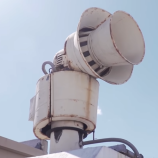
Contrary to popular belief, the rotating Bullard siren atop the California Fruit Building in Sacramento, CA is not an official E.D. Bullard product. In December of 1941, Sacramento ordered two 7½ horsepower, non-coded (7½H(NC)) sirens from E.D. Bullard, and one of these sirens would later be used by R.J. Zievers to make a custom rotating Scream Master siren during the Cold War, using Zievers' "Frost Master" wind machine's rotation platform. Presumably, the Bullard came with no projectors, as custom horns were built for the one-off siren. This siren was originally pole mounted on a Scream Master metal pole, but later moved to the top of the Fruit Building. As with the rest of Sacramento's sirens, it is no longer active. It is unknown whether or not the city's second Bullard was also turned into a rotating siren, or reused at all. Several R.J. Zievers wind machines still survive in California (albeit sometimes missing their blades) and are often mistaken for this siren.
